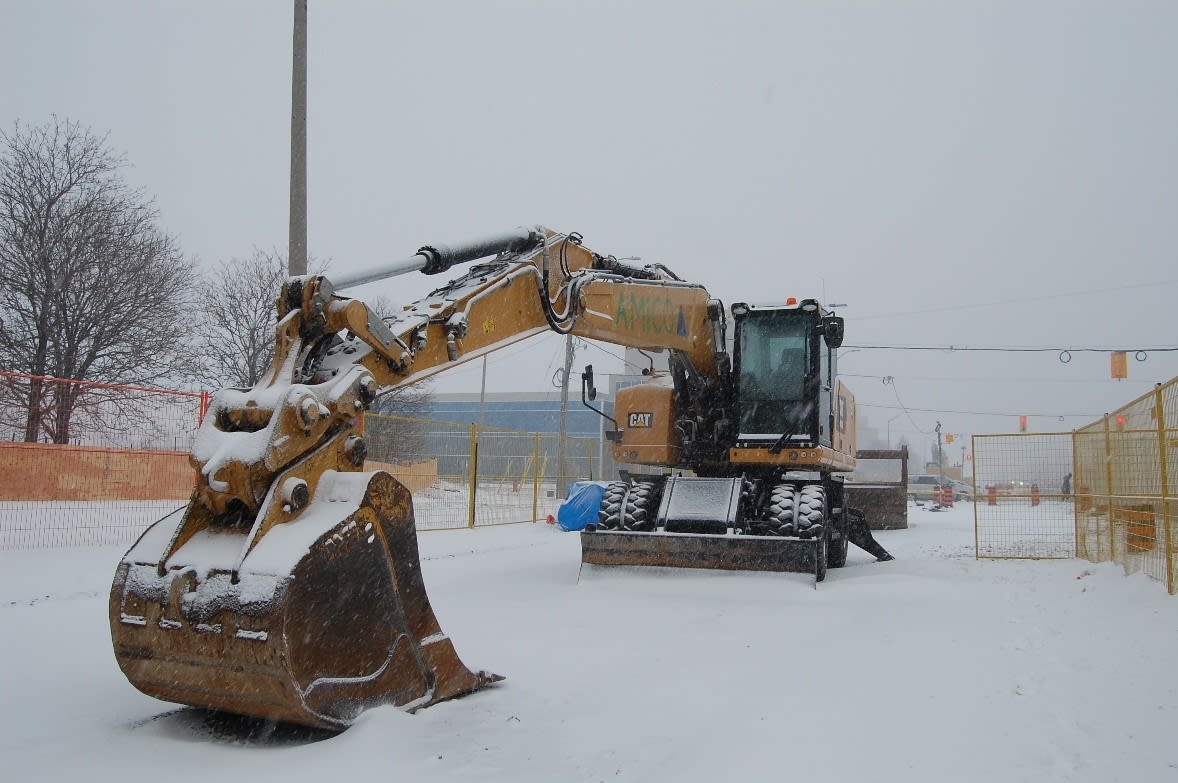Hurontario LRT is an example of extreme weather safety measures
Here’s how construction of the Hurontario LRT line managed to get through this past winter safely,
Mar 30, 2021
We know, our minds are on better weather now.
And we’re all about looking forward.
But as Ontario waves goodbye to March, as well as the snow and cold, we wanted to give one last nod to winter, by explaining how the Hurontario light rail transit (HuLRT) project team made it through the past frigid season, and is ready for when temperatures dip again.
And while we all have warm weather thoughts, there were some interesting ways HuLRT progressed with the right tools and procedures in place – as well as ways crews will protect themselves in the months ahead, including from lightning strikes.
Weather-ready Machinery
Machinery parked away from the main road during a snowstorm to eliminate the risk for pedestrian or vehicle accidents. (Metrolinx photo)
The equipment used to build the new transit line requires special maintenance and storage during colder months. Construction equipment with hydraulic systems need additional time to heat up in frigid temperatures. In the event of a snowstorm, equipment is parked away from the road to reduce the risk of unanticipated road accidents that may occur due to obstruction of sightlines. Hazzard Assessments are conducted to better understand the safest place to store equipment and heavy machinery during extreme weather conditions.
One of the most frequently used machines during cold weather is the hydrovac, which is similar to a giant vacuum cleaner. The hydrovac is used to suck up the earth in areas where there may be delicate utilities, such a fibre or telecoms, and where the use of a normal excavator would be dangerous. These machines are widely popular in Canada because they can cut through the frozen ground during harsh winters without damaging the underground utilities.
Through a hose, pressurized water that has been heated within the water tank is used to penetrate and cut through the ground. It then “vacuums” up the loose dirt to reveal the buried utilities. Without the hydrovac, working through the frozen ground could take several days to complete. The hydrovac makes this process safer and allows crews to complete their task in a matter of hours.
Speaking of digging, it is also important to keep snow from piling into excavated areas. To ensure excavated areas are kept free of snow, crews use a snow fence to control areas from large drifts, as well as clear any build up by hand or machine. Workers must ensure that open and excavated areas are closed off with tarping, fencing and plywood, including signs to warn of potential hazards.
Under severe situations such as high-winds, snowstorms, or thunderstorms, all dozers, excavators, picker trucks, cranes and drills must be evacuated from elevated areas and moved to lower, flatter ground. Booms or hoisted loads are lowered and secured. Materials must be secured by either storing them in areas where they can be protected or fastened to prevent them from flying around.
If workers hear thunder, they are instructed to seek shelter as soon as possible. The decision to return to the worksite is made once the SKYSCAN lightening detector indicates that the storm is far enough away that activities can be resumed safely. This is a special device used to detect how close the storm is and when it’s far enough away and safe to resume activities again.
Personal Protective Equipment Basics
During bad weather, it is imperative that PPE includes proper footwear to prevent any slips and falls that may occur in icy conditions and appropriate garments to keep everyone safe, warm, and dry. Crews wear hard hat liners and heavy-lined jackets, gloves, and lined pants to stay warm.
To reduce winter condition injuries on and near sites, snow clearing, sanding, and salting of high-traffic pedestrian areas are completed frequently. To add further protection, cleated building ramps are installed. Grip-like tape or special paints that promote grip are also used to prevent slips and falls.
The safety of crew members and the public is important during construction of the new LRT line. Ensure that extra caution is taken during inclement weather and always obey construction signage. Stay up to date with ongoing construction for the HuLRT by subscribing to our e-newsletter at www.metrolinx.com/hurontariolrt or follow us on social media @hurontariolrt.
by Erika D’Urbano Communications senior advisor
